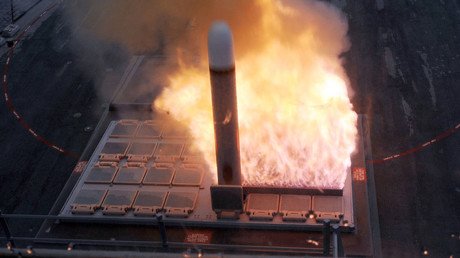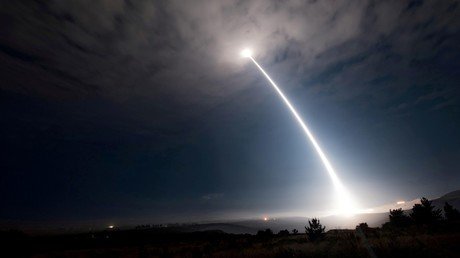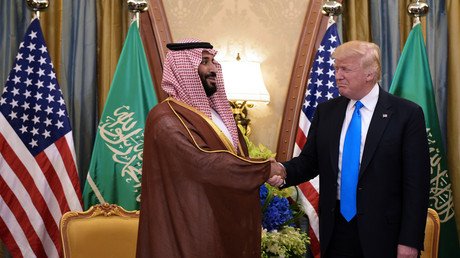Business as usual: US INF pullout will delight arms industry as it threatens to reignite Cold War

Trump has been tearing up treaties since taking office, from halting negotiations on the TPP to NAFTA, but his latest threat to pull out of the nuclear deal, negotiated by President Reagan in the 80s, may be his biggest mistake.
Meanwhile, while US President Donald Trump and his National Security Advisor, the neoconservative firebrand John Bolton, justify their threat by accusing Russia of violating the Intermediate Nuclear Forces (INF) Treaty, the reality is that it has largely been the US that has been the aggressor through the terrifying and costly decades of the Cold War that this latest treaty exit action threatens to re-ignite.
In fact, the US, which has never renounced a policy of using nuclear weapons in a first strike on America's enemies, including Russia and China, began its planning for a nuclear attack to destroy the Soviet Union as early as 1945, when President Harry Truman's War Department and the Pentagon began developing a series of at least nine war plans to use nuclear weapons to destroy all of Russia's industrial centers, the goal being to preserve America's monopoly on atomic bombs.
Those plans, which could have killed 100 million Russians, were only halted by Truman in 1949 when the USSR exploded its own atomic bomb. The only reason they weren't launched may simply have been the lack of enough A-bombs and planes to deliver them (Pentagon generals thought over 400 were needed) .
But while the planning for a catastrophic first strike on the Soviet Union got more or less shelved, once Russia had the bomb, in favor or a tenuous strategy of Mutual Assured Destruction (MAD), the US kept trying to put nuclear weapons and delivery systems close to Russia in the years that followed, even as it and the Soviet Union both developed intercontinental ballistic missiles and nuclear missile-launching submarines that could reach and obliterate each other’s heartlands.
The danger of closer basing of shorter-range ballistic missiles of course is that they give the other side much less warning time to launch a retaliatory counter-strike, thus causing the attacking nation reason to believe it could survive relatively unscathed and undermining MAD as a deterrent.
For years, the US kept huge numbers of both tactical (generally relatively small) and strategic (much larger) nuclear warheads overseas. According to a review of documents by the National Security Archive, published in updated form in 2006, from the early 1950s through the early 1990s — a period of four decades of Cold War — the US kept up to 13,000 nuclear weapons overseas, some at US bases, some in the joint possession of European NATO allies like Belgium, Italy, and Germany.
Of those, 7,000 were kept in Europe for potential use against the Soviet Union. Another country with a large number of nukes was South Korea, with others in the Philippines and elsewhere. South Korea, at the peak in 1964, had 950 US nuclear weapons in warheads, howitzer shells for delivery by plane, inside its borders — weapons which were for potential use against North Korea, China and Russia (the last US nukes were reportedly removed from South Korea in 1991).
'It’s completely unacceptable to break the old treaties on disarmament' https://t.co/KSrUHxPmKD
— RT (@RT_com) October 22, 2018
While many of these thousands of nukes were gravity bombs intended to be delivered by jet aircraft, many were also in the form of missile warheads, particularly in Europe and Turkey.
One of the earliest examples of this effort by the US to ring the USSR with missiles that could strike the country in minutes was the basing of 30 Jupiter missiles in Italy and 15 missiles in Turkey in 1961.
The Jupiter was the US’s first so-called intermediate-range ballistic missile (IRBM), able to carry a 1.1 megaton thermonuclear bomb 1500 miles (2400 kilometers), entering on a ballistic arc at a speed of 10,000 mph. The missiles remained in both countries under US Air Force command until 1963, when they were removed under a secret (from Americans!) agreement to resolve the so-called Cuban Missile Crisis (the one time the Soviet Union attempted during the Cold War era to put IRBMs near US shores).
During that same period 60 Thor ballistic missiles, with a slightly longer range and a 1.4 megaton warhead were based in the UK where they were under the command of the British Royal Air Force. They too were decommissioned in 1963.
READ MORE: US ready to blow another arms control treaty to feed its war economy
But the removal of those intermediate missile threats against the USSR didn’t mean the US was backing off of its aggressive Cold War stance of basing nuclear missiles just a few minutes’ flight from Soviet major cities. Indeed beginning in 1979 and through 1992, the US deployed some 108 Pershing missiles with a range of 1100 miles (1770 km) carrying a 50 kiloton bomb in a variable-entry warhead, as well as another 464 ground-launched Gryphons, a type of cruise missile with a range of 1600 miles (2500 km) carrying a 150 kiloton warhead.
Beginning in the mid-1980s the US developed the BGM-109, a ground-launched version of the Tomahawk missile used by the Navy. Designed to carry a 150 kiloton bomb, the BGM-109 has a range of 1600 miles (2500 kilometers). The plan was to deploy hundreds of these missiles in six locations across Western Europe, in the UK, Belgium, Netherlands, West Germany and Italy. But the plans were delayed because of massive protests against them, especially in the UK, West Germany and Italy. In the end, the INF Treaty reached by President Reagan and Premier Mikhail Gorbachev in 1987 put a halt to the process, and those that had been operational were removed by 1988.
Meanwhile, though, the US had also based hundreds of mobile tactical Lance missiles, with a range of 80 miles (120 km) carrying a 100 kiloton bomb, in Germany and other “front line” Western European countries as far back as 1973. These remained in place through 1992.
Even after the collapse of the Soviet Union, and with the INF Treaty in place, the US has continued to retain some 150-160 nuclear bombs in Turkey, Belgium, Netherlands, Germany and Italy. In a war, these are intended to be delivered to their targets in Russia by planes such as the F-15, F-16 and Tornado.
And of course there are the anti-missile system elements the US has installed more recently in Poland and Romania. These, as Russian President Vladimir Putin has pointed out, could easily be repurposed to launch nuclear attacks on Russian cities. (Few believe the bizarre claim by the US government that these installations are merely a precaution against Iranian missiles.)
It’s a long sorry story of the US taking an aggressive stance towards the Russian people (nuclear weapons don’t distinguish between military and civilian targets).
As David Swanson, director of WorldBeyondWar.org and campaign coordinator of RootsAction.org, says, “If you look at the history, the Soviet Union may not have been a saint or a model of democratic governance, but the US since the victory of the Russian Revolution in 1917 has been out to get Russia. Even during WWII when the USSR was technically an ally, US policymakers considered it an enemy.”
Swanson argues that the main driver of US bellicosity towards Russia, and of the current Trump threat to quit the INF Treaty banning nuclear capable intermediate range missiles and cruise missiles, is basically about “keeping up profits in the arms industry and securing the Pentagon bureaucracy.”
Like this story? Share it with a friend!
The statements, views and opinions expressed in this column are solely those of the author and do not necessarily represent those of RT.
















